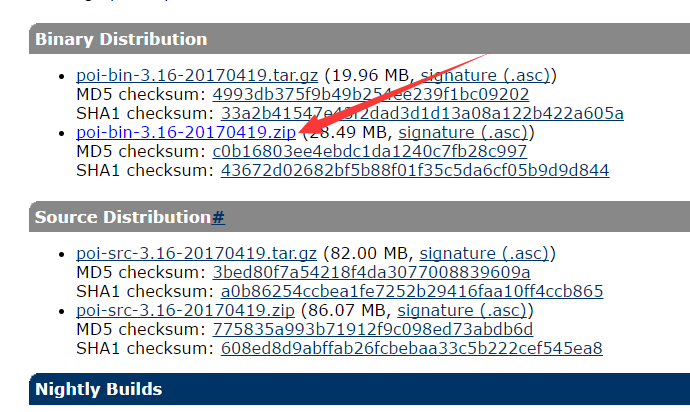1.為項目添加POI
POI官網鏈接

點進去之后下載(上邊的是編譯好的類,下邊的是源代碼)

解壓文件夾,把下面三個文件復制到WebComtent>WEB-INF>lib文件夾下

再把這三個文件復制到Tomcat的lib文件夾下,否則Tomcat會因為找不到類而報錯(這個地方郁悶了一上午)
讀取“.xls”格式使用 import org.apache.poi.hssf.usermodel.*;包的內容,例如:HSSFWorkbook
讀取“.xlsx”格式使用 import org.apache.poi.xssf.usermodel.*; 包的內容,例如:XSSFWorkbook
讀取兩種格式使用 import org.apache.poi.ss.usermodel.* 包的內容,例如:Workbook
由于我是讀取xslx文件所以使用以上幾個jar文件。
注意:

上圖中的兩個文件夾中也有我們需要的jar文件,具體是哪幾個忘記了(當然為了保險也可以把所有的都放進WebContent>WEN-INF>lib下再BuildPath進項目),沒關系,一會運行的過程中會報錯,根據錯誤信息再去找到相關的jar文件BuildPath進去就好,注意還要再Tomcat>lib下放置一份副本。
2.讀取Excel文件
官方教程:鏈接
類庫:鏈接
直接看代碼吧,不難懂。

|
1
2
3
4
5
6
7
8
9
10
11
12
13
14
15
16
17
18
19
20
21
22
23
24
25
26
27
28
29
30
31
32
33
34
35
36
37
38
39
40
41
42
43
44
45
46
47
48
49
50
51
52
53
54
55
56
57
58
59
60
61
62
63
64
65
66
67
68
69
70
71
72
73
74
75
76
77
|
//遍歷一個Excel文件<br>private void getExcelData(File file) { System.out.println("now in getExcelData" ); System.out.println("get file name:"+file.getName().toString()); XSSFWorkbook workBook= null; try { workBook = new XSSFWorkbook(file); int sheetCount = workBook.getNumberOfSheets(); //Sheet的數量 System.out.println("num of sheet is : "+sheetCount); //遍歷每個sheet for(int i=0;i<sheetCount;i++) { XSSFSheet sheet = workBook.getSheetAt(i); //獲取總行數 int rowCount = sheet.getPhysicalNumberOfRows(); System.out.println("num of row : "+ rowCount); System.out.println("i now in sheet : "+ i); //遍歷每一行 for (int r = 0; r < rowCount; r++) { XSSFRow row = sheet.getRow(r); //獲取總列數 int cellCount = row.getPhysicalNumberOfCells(); //遍歷每一列 for (int c = 0; c < cellCount; c++) { XSSFCell cell = row.getCell(c); String cellValue = null; switch (cell.getCellTypeEnum()) { case STRING: //System.out.println("celltype is string"); cellValue = cell.getStringCellValue(); break; case NUMERIC: //System.out.println("celltype is Number");//整數,小數,日期 cellValue = String.valueOf(cell.getNumericCellValue()); break; case BOOLEAN: //System.out.println("celltype is Boolean"); cellValue = String.valueOf(cell.getBooleanCellValue()); break; case FORMULA: //System.out.println("celltype is Formula");//公式 cellValue = "錯誤,不能為公式"; break; case BLANK: //System.out.println("celltype is Blank");//空白 cellValue = cell.getStringCellValue(); break; case ERROR: //System.out.println("celltype is Error"); cellValue = "錯誤"; break; default: //System.out.println("celltype : default"); cellValue = "錯誤"; break; } System.out.println(cellValue.toString()); } } } } catch (IOException e) { System.out.println("File Error IOException : "+e.getMessage()); } catch (Exception e) { // TODO: handle exception } finally { try { workBook.close(); } catch (Exception e) { // TODO Auto-generated catch block e.printStackTrace(); System.out.println("workBook.close()&fileInputStream.close() Error : "+e.getMessage()); } System.out.println("Try Catch : finally"); } System.out.println("hi feipeng8848 getExcelData is done"); } |
以上所述是小編給大家介紹的JavaWeb使用POI操作Excel文件實例,希望對大家有所幫助,如果大家有任何疑問請給我留言,小編會及時回復大家的。在此也非常感謝大家對服務器之家網站的支持!
原文鏈接:http://www.cnblogs.com/feipeng8848/archive/2017/04/28/6781822.html















